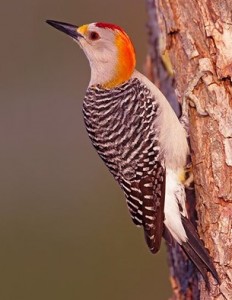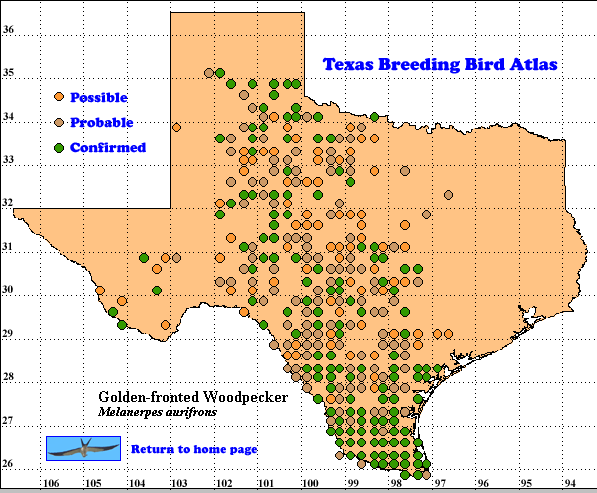The Golden-fronted Woodpecker occurs from southwestern Oklahoma through Texas and Mexico as far south as northern Nicaragua. It is a member of a superspecies that includes the Red-bellied (M. carolinus), Gila (M. uropygialis), Hoffmann’s (M. hoffmannii), and the West Indian(M. superciliaris) woodpeckers (Am. Ornithol. Union 1998). The golden-front is most similar to the Red-bellied Woodpecker with whom it occasionally hybridizes where the ranges of the two species overlap in Oklahoma and Texas (Smith 1987).
The Golden-fronted Woodpecker was described in 1829 from a specimen collected in Mexico. Its occurrence in Texas was poorly known until Woodhouse (1853) reported it to be abundant around San Antonio. The first color illustration of the species was prepared from birds collected during the early l850s at Eagle Pass and Ringgold Barracks by the United States-Mexican Boundary Survey (Baird l859).
Most early observers mentioned the association of the golden-front with old growth mesquite. This relationship was formalized by H. E. Dresser (1865) who used the name “mesquite woodpecker” with reference to the species, thus suggesting that it was ecologically dependent on mesquite. In reality, the golden-front occupies a variety of habitats including mixed oak-juniper-mesquite woodlands as well as riparian woodlands of cottonwood, willow, and cypress (Selander and Giller 1959).
Golden-fronted Woodpeckers are omnivorous. They forage at all levels in trees and on the ground where they search for insects. Acorns, pecans, wild fruits, citrus, whole corn and cornmeal, and even dog food are eaten (Bent 1939, Casto 1973). An inquisitive female golden-front at Bastrop State Park took bread offered by the author and carried it to a nearby tree. Golden-fronts are not shy and commonly visit human habitations and park areas that are found near suitable habitat (Oberholser 1974).
Golden-fronts are often seen perching in the dead top of a tree or on a utility pole where they may remain motionless for several minutes. The vocalizations of the golden-front are similar to those of the Red-bellied Woodpecker but are louder and harsher. Drumming is less frequent than in other species. The golden-front is commonly observed singly or in pairs (Simmons 1925). The golden-front is territorial and defends its nesting trees from others of its species as well as from the closely related Red-bellied Woodpecker (Selander and Giller 1959).
DISTRIBUTION: The Golden-fronted Wood- pecker is a resident breeding species in all areas of Texas except the northernmost Panhandle, all of east Texas and the far western portions of the Trans-Pecos. It is locally common in areas of suitable habitat while being scarce or lacking in surrounding areas. This woodpecker’s range extends south through eastern Mexico to Nicaragua (Howell and Webb 1995).
SEASONAL OCCURRENCE: Courtship and nest-building may begin in early to mid-March. The earliest record of breeding is a set of eggs taken in Travis County, March 30, 1917 (Simmons 1925). Eggs have been found as late as July 6 (Oberholser 1974).The peak of breeding in Texas probably occurs during May. Golden-fronts in Central America commonly produce two and rarely three broods (Skutch 1969). In Texas the golden-front is believed to produce only one or occasionally two broods (Bent 1939). The TBBA data document two nests with young as early as April 10 and a nest with young as late as July 15.
BREEDING HABITAT: Both live and dead trees are used for nesting as well as fence posts, utility poles, and artificial nest boxes. Old growth mesquite is preferred but nests have been found in such diverse species as pecan, live oak, anaqua, willow and hackberry. Placement of the opening of the nest cavity varies from near ground level to as much as 11 m (35 ft) with heights of 2 to 6 m (8 to 20 ft) being common. Six to 10 days are spent by both sexes in construction of the nest cavity. A cavity from a previous year may also be used. The depth of the cavity may range from 15 to 46 cm (6 to 18 in). Golden-fronts are said to be shy when around their nests (Bent 1939).
The 4 to 7 eggs (usually 4 or 5) are incubated by both parents, the male occupying the nest at night. The eggs hatch in 12 to 14 days and both adults feed the nestlings. The male broods the nestlings until about a week before they fledge at around 30 days of age.There is an interval of about three weeks before departure of the first brood and the beginning of the next clutch (Skutch 1969). Pair bonds may be maintained for several years or for life (Selander and Giller 1959).
STATUS The breeding distribution of the Golden-fronted Woodpecker has not significantly changed since the publication of Oberholser’s account in 1974. In spite of the widespread destruction of mesquite wood- lands, the golden-front is still a common species throughout most of its original range. Golden- fronted Woodpeckers have expanded their range into southwest Oklahoma, the Big Bend region and in the Panhandle in the last half of the 20th century (Wauer 1996, Husak and Maxwell 1999, 2000, Lockwood and Freeman 2004).
The highest relative abundances found in the United States on 40 km (25 mi) Breeding Bird Survey (BBS) routes were in Jim Hogg, Brooks and Zapata counties (24-28 woodpeckers detected per route; Price et al 1995). Data from the 80 BBS routes in Texas on which this species was detected produced a 95% confidence interval of -3.5 to +1.0% population change per year for the period 1966-2005 (Sauer et al. 2005). This interval suggests that population change for this species in Texas has been relatively small.
Text by Stan D. Casto (Posted with updates 2006)
Literature cited.
American Ornithologists’ Union. 1998. Checklist of North American birds, 7th ed. Am, Ornithol. Union, Washington, DC.
Baird, S. F. 1859. United States and Mexican Boundary Survey, Vol. 2, Pt. 2. Birds of the Boundary
Bent, A. C. 1939. Life histories of North American woodpeckers, U.S. Nat. Mus. Bull. 174.
Casto, S. D. 1973. Cornmeal as food of the Cactus Wren and Golden-fronted Woodpecker. Bull. Tex. Ornithol. Soc. 6(1):7.
Dresser, H. E. 1865. Notes on the birds of southern Texas. Ibis 1: 466-495.
Howell, S. N. G. and S. Webb. 1995. A guide to the birds of Mexico and northern Central America. Oxford University Press, New York.
Husak, M. S. and T. C. Maxwell. 1999. Golden-fronted Woodpecker (Melanerpes aurifrons). In The Birds of North America, No. 373 (A. Poole and F. Gill, eds.). The Birds of North America, Inc., Philadelphia, PA.
Husak, M. S. and T. C. Maxwell. 2000. A. review of 20th century range expansions and population trends of the Golden-fronted Woodpecker (Melanerpes aurifrons): historical and ecological perspectives. Texas J. Sci. 52 (4): 275-284.
Lockwood, M. W. and B. Freeman. 2004. The TOS handbook of Texas birds. Texas A&M University Press, College Station.
Oberholser, H. C. 1974. The bird life of Texas. University of Texas Press, Austin.
Price, J., S. Droege, and A. Price. 1995. The summer atlas of North American birds. Academic Press, New York.
Sauer, J. R., J. E. Hines, and J. Fallon. 2005. The North American Breeding Bird Survey, results and analysis 1966-2005. Version 6.2 2006. USGS Patuxent Wildlife Research Center, Laurel MD < http://www.mbr-pwrc.usgs.gov/bbs>
Selander, H. K. and D. R. Giller.1959. Interspecific relations of woodpeckers n Texas.Wilson Bull. 71: 107-124.
Simmons, C. F. 1925. Birds of the Austin region.University of Texas Press, Austin.
Skutch, A. F. 1969. Life histories of Central American birds, Pac. Coast Avifauna, No. 35.
Smith, J. I. 1987. Evidence of hybridization between Red-bellied and Golden-fronted Woodpeckers. Condor 89: 377-386.
Wauer, R. H. 1996. A field guide to birds of the Big Bend, 2nd ed. Gulf Publishing, Houston, TX.
Woodhouse, S. W. 1853. Report of an expedition down the Zuni and Colorado rivers by Captain L. Sitgreaves. Zoology (Birds), pp. 58-105. Washington, DC.

